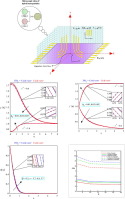当前位置:
X-MOL 学术
›
Powder Technol.
›
论文详情
Our official English website, www.x-mol.net, welcomes your
feedback! (Note: you will need to create a separate account there.)
Investigation on thermophysical properties of Tio 2 –Cu/H 2 O hybrid nanofluid transport dependent on shape factor in MHD stagnation point flow
Powder Technology ( IF 4.5 ) Pub Date : 2017-12-01 , DOI: 10.1016/j.powtec.2017.09.006 S.S. Ghadikolaei , M. Yassari , H. Sadeghi , Kh. Hosseinzadeh , D.D. Ganji
Powder Technology ( IF 4.5 ) Pub Date : 2017-12-01 , DOI: 10.1016/j.powtec.2017.09.006 S.S. Ghadikolaei , M. Yassari , H. Sadeghi , Kh. Hosseinzadeh , D.D. Ganji

|
Abstract An analysis on the subject of “induced magnetic field effect on stagnation flow of a TiO2-Cu/water hybrid nanofluid over a stretching sheet” has been carried out in this paper. It should be noted that hybrid nanofluid consists of two or more types of nanoparticles along with a base fluid and it is used to increase the heat transfer. Furthermore, the non-linear differential equations modeling this issue are included in this article. In order to solve these equations numerically, Runge-Kutta Fehlberg method is used as a numerical method in this problem. The main objective of this paper is to investigate the effects of change in parameters of stretching ratio parameter (A ∗ ), nanoparticles volumetric fractions (∅ 2 ), magnetic parameter (β) and reciprocal magnetic Prandtl number (λ) on the functions including velocity, induced magnetic field and temperature for both Cu-water nanofluid and TiO2-Cu/water hybrid nanofluid. Also Lorentz force which is derived from magnetic field is mentioned in this section. In addition, the impacts of (∅ 2 ), (β) and (λ) on the profiles of nanofluid and hybrid nanofluid temperature for three categories of nanoparticle shapes named brick, cylinders, and platelets are analyzed. At the end, the influences of (∅ 2 ), (β) and (λ) on skin friction coefficient (C f ) and Nusselt number (Nu x ) for Cu-water nanofluid and TiO2-Cu/water hybrid fluid for different nanoparticles shapes are discussed. In all of these studies it can be seen that applying platelets shaped nanoparticles is more effective.
中文翻译:

依赖于 MHD 驻点流中形状因子的 Tio 2 –Cu/H 2 O 混合纳米流体传输的热物理性质研究
摘要 本文对“感应磁场对TiO2-Cu/水杂化纳米流体在拉伸片上的滞流效应”这一课题进行了分析。应该注意的是,混合纳米流体由两种或多种类型的纳米颗粒以及基液组成,用于增加传热。此外,本文还包括对这个问题进行建模的非线性微分方程。为了数值求解这些方程,Runge-Kutta Fehlberg 方法被用作该问题的数值方法。本文的主要目的是研究拉伸比参数 (A ∗ )、纳米颗粒体积分数 (∅ 2 )、磁参数 (β) 和倒易磁普朗特数 (λ) 参数的变化对包括速度在内的函数的影响。 , Cu-水纳米流体和TiO2-Cu/水混合纳米流体的感应磁场和温度。本节还提到了由磁场导出的洛伦兹力。此外,分析了(∅ 2 ),(β)和(λ)对纳米流体和混合纳米流体温度曲线的影响,用于三类纳米颗粒形状,即砖形,圆柱体和片状。最后,(∅ 2 )、(β) 和(λ) 对不同纳米粒子的Cu-水纳米流体和TiO2-Cu/水混合流体的皮肤摩擦系数(C f ) 和努塞尔数(Nu x ) 的影响形状进行了讨论。在所有这些研究中,可以看出应用血小板形纳米粒子更有效。本节还提到了由磁场导出的洛伦兹力。此外,分析了(∅ 2 ),(β)和(λ)对纳米流体和混合纳米流体温度曲线的影响,用于三类纳米颗粒形状,即砖形,圆柱体和片状。最后,(∅ 2 )、(β) 和(λ) 对不同纳米粒子的Cu-水纳米流体和TiO2-Cu/水混合流体的皮肤摩擦系数(C f ) 和努塞尔数(Nu x ) 的影响形状进行了讨论。在所有这些研究中,可以看出应用血小板形纳米粒子更有效。本节还提到了由磁场导出的洛伦兹力。此外,分析了(∅ 2 ),(β)和(λ)对纳米流体和混合纳米流体温度曲线的影响,用于三类纳米颗粒形状,即砖形,圆柱体和片状。最后,(∅ 2 )、(β) 和(λ) 对不同纳米粒子的Cu-水纳米流体和TiO2-Cu/水混合流体的皮肤摩擦系数(C f ) 和努塞尔数(Nu x ) 的影响形状进行了讨论。在所有这些研究中,可以看出应用血小板形纳米粒子更有效。讨论了(∅ 2 )、(β)和(λ)对不同纳米颗粒形状的Cu-水纳米流体和TiO2-Cu/水混合流体的皮肤摩擦系数(C f )和努塞尔数(Nu x )的影响。在所有这些研究中,可以看出应用血小板形纳米粒子更有效。讨论了(∅ 2 )、(β)和(λ)对不同纳米颗粒形状的Cu-水纳米流体和TiO2-Cu/水混合流体的皮肤摩擦系数(C f )和努塞尔数(Nu x )的影响。在所有这些研究中,可以看出应用血小板形纳米粒子更有效。
更新日期:2017-12-01
中文翻译:

依赖于 MHD 驻点流中形状因子的 Tio 2 –Cu/H 2 O 混合纳米流体传输的热物理性质研究
摘要 本文对“感应磁场对TiO2-Cu/水杂化纳米流体在拉伸片上的滞流效应”这一课题进行了分析。应该注意的是,混合纳米流体由两种或多种类型的纳米颗粒以及基液组成,用于增加传热。此外,本文还包括对这个问题进行建模的非线性微分方程。为了数值求解这些方程,Runge-Kutta Fehlberg 方法被用作该问题的数值方法。本文的主要目的是研究拉伸比参数 (A ∗ )、纳米颗粒体积分数 (∅ 2 )、磁参数 (β) 和倒易磁普朗特数 (λ) 参数的变化对包括速度在内的函数的影响。 , Cu-水纳米流体和TiO2-Cu/水混合纳米流体的感应磁场和温度。本节还提到了由磁场导出的洛伦兹力。此外,分析了(∅ 2 ),(β)和(λ)对纳米流体和混合纳米流体温度曲线的影响,用于三类纳米颗粒形状,即砖形,圆柱体和片状。最后,(∅ 2 )、(β) 和(λ) 对不同纳米粒子的Cu-水纳米流体和TiO2-Cu/水混合流体的皮肤摩擦系数(C f ) 和努塞尔数(Nu x ) 的影响形状进行了讨论。在所有这些研究中,可以看出应用血小板形纳米粒子更有效。本节还提到了由磁场导出的洛伦兹力。此外,分析了(∅ 2 ),(β)和(λ)对纳米流体和混合纳米流体温度曲线的影响,用于三类纳米颗粒形状,即砖形,圆柱体和片状。最后,(∅ 2 )、(β) 和(λ) 对不同纳米粒子的Cu-水纳米流体和TiO2-Cu/水混合流体的皮肤摩擦系数(C f ) 和努塞尔数(Nu x ) 的影响形状进行了讨论。在所有这些研究中,可以看出应用血小板形纳米粒子更有效。本节还提到了由磁场导出的洛伦兹力。此外,分析了(∅ 2 ),(β)和(λ)对纳米流体和混合纳米流体温度曲线的影响,用于三类纳米颗粒形状,即砖形,圆柱体和片状。最后,(∅ 2 )、(β) 和(λ) 对不同纳米粒子的Cu-水纳米流体和TiO2-Cu/水混合流体的皮肤摩擦系数(C f ) 和努塞尔数(Nu x ) 的影响形状进行了讨论。在所有这些研究中,可以看出应用血小板形纳米粒子更有效。讨论了(∅ 2 )、(β)和(λ)对不同纳米颗粒形状的Cu-水纳米流体和TiO2-Cu/水混合流体的皮肤摩擦系数(C f )和努塞尔数(Nu x )的影响。在所有这些研究中,可以看出应用血小板形纳米粒子更有效。讨论了(∅ 2 )、(β)和(λ)对不同纳米颗粒形状的Cu-水纳米流体和TiO2-Cu/水混合流体的皮肤摩擦系数(C f )和努塞尔数(Nu x )的影响。在所有这些研究中,可以看出应用血小板形纳米粒子更有效。











































 京公网安备 11010802027423号
京公网安备 11010802027423号